Editor’s Note July 2016: We’re bringing back this popular photo essay to highlight the hidden world of alleys. As cities grow, more people are transforming alleys into viable community spaces. Check out how alleys are becoming a bit brighter (and greener) below. And take a peak at Citylab’s recent article for a look at more revitalized and repurposed alleys.

Once a stinking strip of menace that was friendlier to rats and crime than to hummus and dancing, Seattle’s Nord Alley is an urban place transformed. Cleared of dumpsters and filth, it now hosts art exhibits, blooming flowers, and a mobbed monthly party (pictured above). Nord is the leading edge of a trend just catching on in Cascadia: the reclamation of downtown alleys as lively, even lovely, public realms.
Here’s Nord Alley before its transformation. . .

. . . and after. The dumpsters are gone, and the waste collector now visits twice a day, picking up sorted and bagged trash, compost, and recycling. Instead, there’s a photography exhibit.
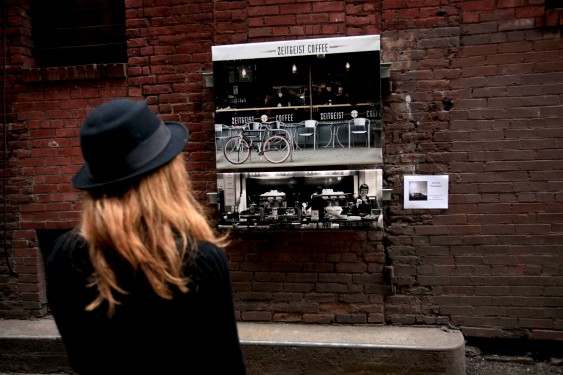
Another before view . . .
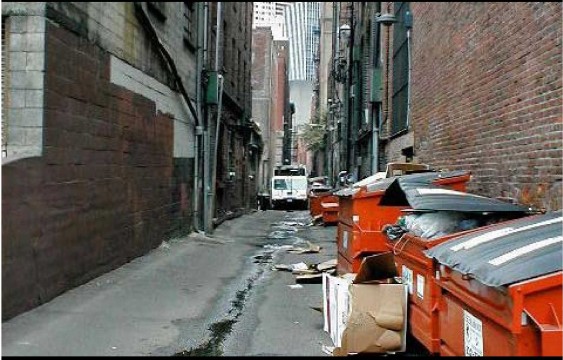
. . . and after, at one of many parties to watch high-stakes soccer games on a big screen.

Led by International Sustainability Institute’s Todd Vogel, Nord Alley’s change-over required limited physical improvement. Vogel and his neighbors removed the boards from the windows, and bought some yard furniture and plants from Craigslist. Seattle’s Alley Art Project assembled business owners, artists, and the City of Seattle to hang a glass and metal sculpture over the Nord Alley (video, at 5:50). Most important, Vogel began hosting parties to coincide with the monthly art walk in Nord’s Pioneer Square neighborhood. Here is the Seattle Latin Fusion band Manigua at a recent event:

To Vogel, alleys are a neglected opportunity in the urban landscape: “Alleys are a huge wasted asset, but it won’t require too much to reclaim them.” (More from Vogel and footage of the alley are here). University of Washington students Mary Fialko and Jennifer Hampton agree. They studied downtown Seattle’s alleys and determined that laneways cover almost half as much space as all of the zone’s parks, squares, and existing pedestrian-oriented streets. In other words, reclaiming alleys could increase by almost half the pedestrian area of downtown Seattle.
Imagine a Seattle in which the half of downtown blocks with alleys have spaces more like Seattle’s one truly great alley: Post Alley, pictured below at its south end. . .

. . . and its main north section.
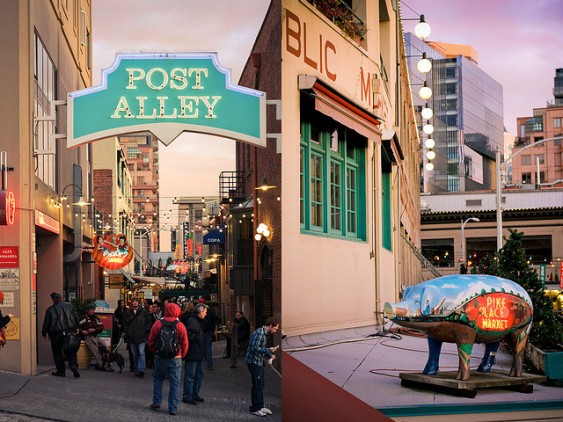
But Post Alley is in the tourist-oriented Pike Place Market. That’s why the transformation of the unremarkable Nord Alley could be such an important glimpse of the future: such workaday alleys have huge potential. In places across the urban Northwest and beyond, neighbors are beginning to reclaim their lanes, turning them into pedestrian passages, marketplaces, and even gathering places—car-free, human-scaled, edgy and intimate. The possibilities of these neglected urban courtyards are ample, and city-makers are taking note.
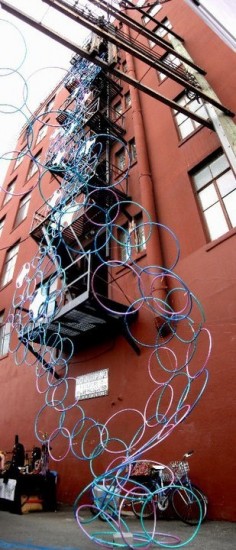
In Vancouver, BC, a non-profit called Livable Laneways has revamped an alley in the city’s Mount Pleasant neighborhood. (Pictured above is its Hula-Hoop sculpture. More photos here). Working with community members and an arts group called Vancouver Design Nerds, and supported by the city’s livability initiative VIVA Vancouver, Livable Laneways is transforming an underused alley into a pedestrian link. The group has added planter boxes, road barriers, and paint. It has also invited neighbors into the alley with markets, art installations, and other public events. Viva Vancouver, for its part, is watching closely, and hoping that success in Mount Pleasant will create a template it can replicate elsewhere, as called for in the city’s Greenest City Action Plan.
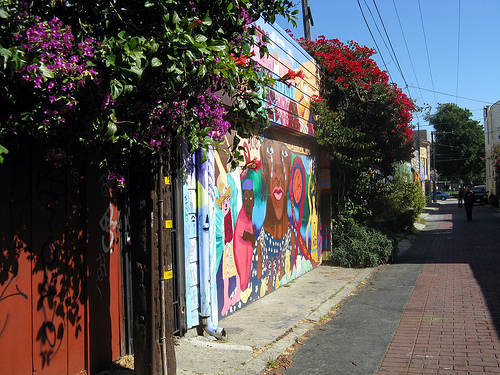
In California, San Francisco’s Mission District has stunning murals (excellent slideshow), some painted as early as the 1970s, that tell the social and political story of the Mission and its people. (Pictured above is one in Balmy Alley.) But it is San Francisco’s Chinatown neighborhood—arguably the most densely settled neighborhood in the United States outside of Manhattan—that is home to the more-impressive re-do of its alleys. In 1998, San Francisco approved for Chinatown the only alley master plan then in force in the United States. The plan calls for renovating 31 alleys. The prime mover behind the plan was the non-profit Chinatown Development Commission, which saw reviving alleys as a way to reclaim community assets. Chinatown’s alleys are integral to the neighborhood’s pedestrian network (as illustrated by the photo below). So far, San Francisco has updated almost a dozen of Chinatown’s alleys, installing new paving, street furniture, stormwater features, and public art.

Meanwhile, San Francisco architect David Winslow has been advancing the redevelopment of the Linden “living alley” (pictured below) in the Hayes Valley neighborhood. Winslow wrote in the San Francisco Chronicle: “Nearly 30 percent of urban space is given to streets, including alleys.” On Linden, change proceeded in steps: a property owner fixed up a decaying building, a coffee shop moved in, the community developed a plan for the length of the alley, landscaping created green space and provided a place for rainwater to percolate into the soil, and finally the city repaved the alley so it would all be on one level, with no distinction between street and sidewalk.

Concerted alley renovation efforts remain young in San Francisco, as they are in Cascadia, but they’re far advanced in Melbourne, Australia, a city that has been working for two decades to create a pedestrian-friendly downtown. Melbourne’s laneways are at the heart of the effort. The central city is built on a grid of large blocks, and alleys cut the blocks up into pedestrian-scaled pieces. Melbourne’s initiative has advanced far beyond the plants-and-street-furniture phase of Seattle’s Nord Alley. It has not only permitted but encouraged the remodeling of its alleys into outdoor cafés, marketplaces, and other pedestrian Meccas. Melbourne also vigorously promotes street art projects in its alleys (good video). The results of these efforts, captured in this Streetfilms video, have been spectacular.
Rob Adams, Melbourne’s director of city design, says the change occurred as Melbourne began to require that every development in the city take a careful look at how buildings meet the street. The key to thriving pedestrian places, he says, is in the details of urban life (like the traffic-blocking bollards below in Melbourne’s Hosier Alley). It’s in the quality of the public art and paving, rather than in big architectural projects. Adams says, “We’ve got to rediscover the small.”

In the alley renovation league, Melbourne has leaped into the global lead after commissioning a 1994 study by Danish architect and planner Jan Gehl of Gehl Architects. Instead of putting the study on the shelf as so many cities might have, Melbourne quickly set to work implementing its recommendations, with the kinds of happy results visible in the alley mural pictured below.
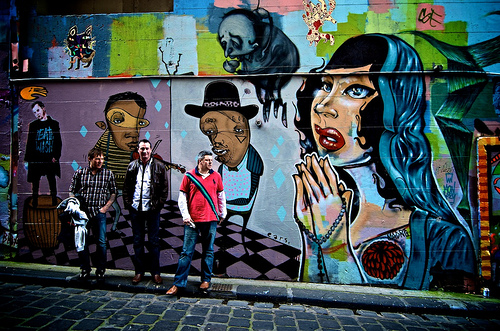
It’s a good sign, therefore, that Seattle hired Gehl Architects to perform a similar downtown study. Released in 2009, it includes recommendations to view alleys as “Blue-Green Lungs” of downtown—places to grow plants, perform water filtration, and provide back routes for people on foot and bikes. Downtown Seattle has alleys in about half of its blocks, but most only function as service ways and do not have the paving, lighting, or building details that are important to attracting pedestrians.
As projects like Nord Alley and Vancouver’s Livable Laneways spread in Cascadia, alleys will evolve from minuses—stinking service roads—to pluses. Melbourne’s Rob Adams sums up the process: “To change cities will always be a slow process and cannot be achieved overnight through silver-bullet solutions of grand architecture. It is more about the slow incremental improvement of the most important piece of public space in the city—namely, our streets.”
That’s a lesson that Todd Vogel and the creators of Nord Alley have already mastered.
Livable Laneways has yet to schedule its next event, but the next Nord Alley party is on September 1, from 5:30 to 8:30 pm. Details here.
Guest blogger Alyse Nelson is a city planner for a small town in Kitsap County, Washington. She spends some of her spare time researching for Sightline on topics such as pedestrian carts and cargo bikes. She last wrote for Sightline about Denmark’s family-friendly courtyard housing. Alan Durning also contributed to this post.

Comments are closed.